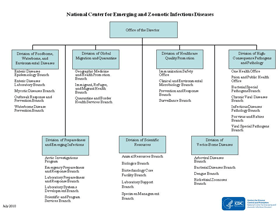About the National Center for Emerging and Zoonotic Infectious Diseases
At the National Center for Emerging and Zoonotic Infectious Diseases (NCEZID), we aim to detect, prevent, and control infectious diseases from spreading, whether they are naturally occurring, unintentional, or the result of terrorism. We focus on infectious diseases that
- occur when people travel to different parts of the world because every place has a different variety of foods, water sources, bugs, and animals that can spread diseases
- occur when populations are displaced by natural disasters or man-made disasters (like wars)
- are spread from one person to another and through food, water, bugs, and animals
- are detected and diagnosed by laboratory tests and procedures
- are spread in health care settings
By understanding how and why these infectious diseases spread, we can stop them from spreading and prevent them from occurring in the first place.
Our focus is on not just the United States but other parts of the world as well because we are living in an interconnected world where infectious diseases continue to present challenges. We protect populations in the United States and globally through
- leadership
- partnerships
- epidemiologic and laboratory studies
- disease surveillance and outbreak response
- applied research
- activities to strengthen clinical and public health laboratories, for example with quality systems, standards, and practices
- sharing vital health information and educating the public and our partners on ways to protect people from infectious diseases.
NCEZID unites leadership, staff, and resources from two former centers at CDC: the National Center for Preparedness, Detection, and Control of Infectious Diseases, and the National Center for Zoonotic, Vector-Borne, and Enteric Diseases. Our center aims to enhance CDC's ability to work with partners to address a broad range of emerging and zoonotic microbial threats. NCEZID also creates a clear and compelling vision for addressing emerging and zoonotic infections.
One of our greatest strengths is our diverse workforce. We are microbiologists, epidemiologists, educators, chemists, ecologists, demographers, statisticians, health economists, veterinarians, health communicators, and information technology experts. We are nurses and medical doctors in cities and rural areas. We are infection control practitioners. We are health officials keeping the nation’s 20 quarantine stations on alert every minute of every day.
With this diverse workforce, we collaborate with other CDC centers and national and global partners to conduct, coordinate, and support infectious disease surveillance, research, and prevention. Each of the center’s seven divisions complements this cross-cutting mission, working with internal and external partners to improve public health.
NCEZID Divisions
Note: Because NCEZID is a new center, some of the information on the following web pages might not be up-to-date in showing where programs are located organizationally within CDC or with regard to program names.
- Division of Foodborne, Waterborne, and Environmental Diseases (DFWED) strives to prevent illness, disability, and death caused by foodborne, waterborne, and mycotic diseases in the United States and around the world. Key activities include enteric disease epidemiology and laboratory programs, outbreak response and prevention, waterborne disease prevention, and the mycotic diseases program.
- Division of Global Migration and Quarantine (DGMQ) works to prevent the introduction, transmission, or spread of communicable diseases from foreign countries into the United States. Major activities include administering regulations related to travelers and imported animals and animal products; developing and coordinating disease screening programs for immigrants and refugees; overseeing CDC quarantine stations; disseminating health information for international travelers; developing measures to prevent the introduction of zoonotic diseases into the United States; and identifying diseases in mobile populations.
- Division of Healthcare Quality Promotion (DHQP) protects patients and healthcare personnel and promotes safety and quality in healthcare delivery systems. Examples of activities include programs for addressing antimicrobial resistance; blood and tissue safety; safety of immunizations; and preventing healthcare-associated infections and other adverse events affecting patients and healthcare workers. DHQP also oversees the National Healthcare Safety Network, a surveillance system operating in select hospitals in all states and being implemented in all hospitals in five states.
- Division of High-Consequence Pathogens and Pathology (DHCPP) prevents illness and death caused by many viral, bacterial, and prion diseases of public health importance in the United States and throughout the world. Major programs include the One Health Office, infectious disease pathology, viral and bacterial special pathogens programs, and the chronic viral disease program.
- Division of Preparedness and Emerging Infections (DPEI) (formerly Division of Bioterrorism Preparedness and Response (DBPR) and Division of Emerging Infections and Surveillance Services (DEISS) provides leadership for CDC’s activities to strengthen preparedness for infectious disease emergencies as well as operational support for noninfectious disease emergencies, such as natural disasters; helps establish and support platforms for infectious disease prevention and control; promotes effective, standards-based infectious disease surveillance; and builds public health capacity. DPEI includes the Arctic Investigations Program in Anchorage, Alaska; the Emerging Infections Program; the Epidemiology and Laboratory Capacity program; the Laboratory Systems Development program; training and fellowships in infectious diseases; and health economics research and resources related to infectious diseases.
- Division of Scientific Resources (DSR) provides laboratory products (e.g., cultures, reagents, and supplies), services, and specialized expertise (e.g., use of advanced technological equipment) to CDC staff and programs. Activities include applied research and diagnostic programs on the use of animal models; basic and applied research in cell biology and in the expansion of tissue-culture technology; maintenance of a bank for epidemiologically important biological specimens; CDC Drug Service; specimen receipt and management; distribution of select agents; and coordination of Clinical Laboratory Improvement Amendment (CLIA) activities within CDC.
- Division of Vector-Borne Diseases (DVBD) serves as a national and international reference center for vector-borne viral and bacterial diseases. DVBD activities include epidemiologic and laboratory programs that focus on the prevention and control of arboviral diseases, bacterial vector-borne diseases, dengue, and rickettsial diseases.
Contact Us:
- Centers for Disease Control and Prevention
1600 Clifton Rd
Atlanta, GA 30333 - 800-CDC-INFO
(800-232-4636)
TTY: (888) 232-6348
24 Hours/Every Day - cdcinfo@cdc.gov

 Beth P. Bell, MD, MPH, is the director of the National Center for Emerging and Zoonotic Infectious Diseases (NCEZID).
Beth P. Bell, MD, MPH, is the director of the National Center for Emerging and Zoonotic Infectious Diseases (NCEZID).


